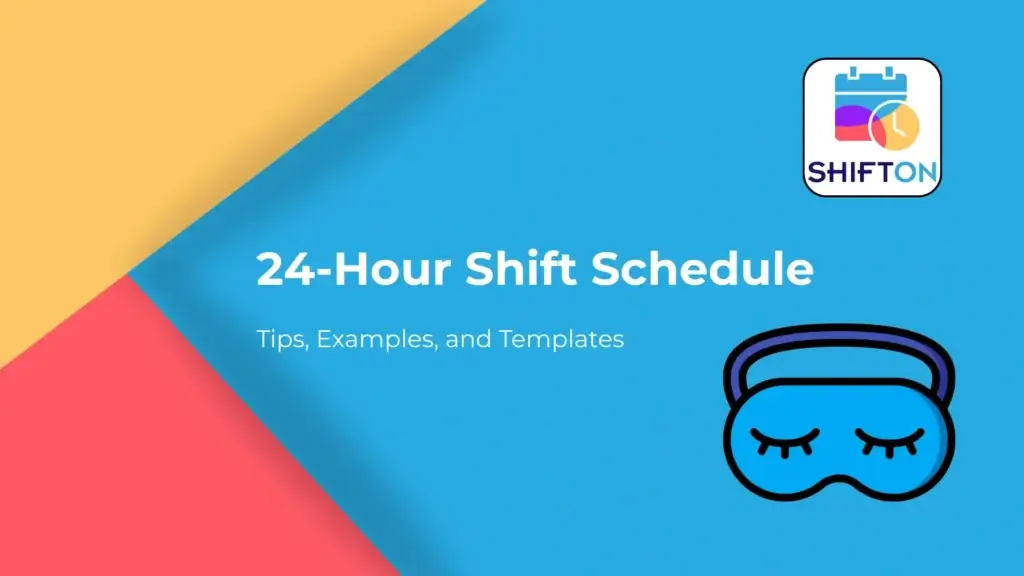24-Hour Shift Schedules Concept
Companies running around the clock need reliable 24-hour shift schedules to cover every hour of the day. A key part of such scheduling is to ensure there are no operational gaps while also taking care of employees' well-being. This involves distributing work hours among employees across different shifts, whether rotating, fixed, or split. By doing so, businesses can maintain seamless operations while providing employees with the rest and work-life balance they require.Scheduling can become a major administrative challenge, especially when done manually. Without automated tools like Shifton, businesses can find it difficult to manage overlapping shifts, shift swapping, and labour law compliance. With advanced scheduling software, businesses can create a well-balanced 24-hour shift schedule that is both flexible and compliant with regulations.What is a 24-Hour Shift Schedule
A 24-hour shift schedule refers to a work arrangement where employees work in shifts to cover a full 24 hours each day. It is common in industries like healthcare, law enforcement, emergency services, and transport, where operations must continue non-stop. These schedules can vary greatly depending on business needs, with common shifts lasting 8, 10, or 12 hours.But how do 24-hour shifts work in practice? Employees are split into teams, with each team assigned to a shift covering part of the day. Shift schedules are typically divided into the following categories:- Morning Shift covers the first part of the day, typically 7 AM to 3 PM.
- Evening Shift takes over after the morning shift, running from 3 PM to 11 PM.
- Night Shift, also known as the "graveyard shift", covers late hours from 11 PM to 7 AM.
Key Elements of a 24-Hour Shift Schedule
The effectiveness of a 24-hour shift schedule hinges on careful planning and management. Here are a few key factors that determine its success:- Depending on the industry and business requirements, shifts may last 8, 10, or 12 hours. While 8-hour shifts allow for a better work-life balance, 12-hour shifts reduce the number of handovers but may increase employee fatigue.
- Ensuring employees have adequate rest between shifts is essential to avoid burnout and ensure sustained productivity.
- The schedule must ensure that critical positions are covered across all shifts, especially during peak hours or emergencies.
- Some schedules rotate employees through different shifts, while others keep employees on the same fixed shifts. The right choice depends on business needs and employee preferences.
Challenges of Implementing 24-Hour Shift Schedules
Though 24-hour shift schedules are a necessity for many businesses, they come with unique challenges. Efficient implementation requires consideration of employee well-being, labour laws, and operational requirements.1. Employee Fatigue
Long hours, especially overnight shifts, can lead to physical and mental fatigue. Without adequate rest periods, employees may experience burnout, reduced productivity, and an increased risk of errors. Night shifts, in particular, disrupt circadian rhythms, making it harder for employees to stay alert.2. Compliance with Labour Laws
Labour laws vary from region to region, but they generally regulate maximum working hours, mandatory break periods, and overtime pay. It is essential that businesses comply with these regulations when implementing a 24-hour shift schedule, as violations can result in legal penalties and strained employer-employee relationships.3. Communication Challenges
In a business with multiple shifts, maintaining effective communication across teams can be tricky. Employees on different shifts may have limited interaction, which can lead to misunderstandings or missed updates. Ensuring that employees are kept informed about their schedules, tasks, and any changes in company policies is critical to the smooth operation of 24/7 businesses.4. Gaps in Coverage
Another common challenge is ensuring complete coverage of all shifts. Poorly managed schedules can leave certain hours understaffed, leading to disruptions in service. Managers must carefully plan shifts to avoid overlaps or gaps in coverage, especially during critical periods.Types of 24-Hour Shift Schedules
There are several types of 24-hour shift schedules, each designed to suit different business needs. Choosing the right schedule depends on factors like the number of employees, the nature of the work, and the level of coverage required.Rotating Shifts
A rotating shift schedule allows employees to work different shifts on a recurring basis. This means that an employee might work the day shift for one week, followed by the night shift the following week. Rotating shifts are particularly useful for ensuring fairness, as they distribute undesirable shifts, like overnight work, evenly among employees.Rotating shifts also give employees the chance to experience different times of the day, which can lead to greater job satisfaction. However, they can also disrupt employees' personal lives, especially when the rotation includes night shifts.Fixed Shifts
In a fixed-shift system, employees work the same shift every day. This could mean working only during the day, only at night, or only in the evening. Fixed shifts provide stability and consistency for employees, allowing them to plan their personal lives more easily. However, fixed night shifts can still lead to long-term health issues, as consistent night-time work can interfere with sleep patterns.Split Shifts
A split shift divides the workday into two separate periods, allowing employees a long break in between. For example, an employee might work from 6 AM to 10 AM and then return for a second shift from 4 PM to 8 PM. Split shifts offer flexibility but can disrupt daily routines and lead to increased travel time for employees.Tips for Managing 24-Hour Shift Schedules
Creating and managing an effective 24-hour shift schedule requires a combination of strategy, tools, and communication. Here are some practical tips to help you manage your 24-hour schedule more effectively:Optimise Staffing Levels
Not all hours of the day require the same number of staff. For example, hospitals may need more staff during peak hours, while a security company may require additional personnel at night. Analysing historical data on demand and workload can help you determine optimal staffing levels for each shift. But how do 24-hour shifts work in such cases? By using data-driven insights, you can avoid overstaffing during low-demand hours and understaffing during peak times, maximising operational efficiency.By regularly evaluating staffing needs, you will ensure that the right number of employees are on hand at all times, preventing burnout while keeping operations smooth.Ensure Adequate Rest Periods
Fatigue is a major concern when managing 24/7 schedules. Employees who work long or irregular hours are more likely to make mistakes, have accidents, and face health issues. Make sure your employees have enough rest between shifts to maintain their health and productivity.Most labour laws require mandatory rest periods between shifts. For instance, many regions require at least an 11-hour break between shifts. By including these rest periods in your schedule, you can prevent employee burnout and ensure compliance with labour laws.Use Scheduling Software
Manual scheduling is not only time-consuming but also prone to errors. That's where scheduling software like Shifton comes in. With Shifton, you can automate shift creation, manage shift swaps, and ensure compliance with labour regulations.Shifton's powerful features, such as pre-made templates and shift notifications, make it easy to manage even the most complex 24-hour shift schedule. The platform’s ability to optimise shift assignments based on employee preferences and qualifications also ensures a more efficient and content workforce.Communicate Clearly with Employees
In a 24/7 operation, clear communication is crucial to ensure smooth transitions between shifts. Employees need to know their schedules well in advance and be updated about any changes. Tools like Shifton can automate communication, ensuring that employees receive real-time updates on their shifts via email or mobile notifications.Good communication not only enhances scheduling efficiency but also fosters better relationships between management and employees. When employees feel informed and involved, they are more likely to be committed and motivated at work.Examples of 24-Hour Shift Schedules
Let’s look at a few real-world examples of 24-hour shift schedules that are commonly used in various industries. These examples highlight how businesses can structure their shifts to maintain around-the-clock coverage.Example 1: 4-On, 4-Off Schedule
In the 4-on, 4-off schedule, employees work four 12-hour shifts consecutively, followed by four days off. This schedule is especially popular in industries that require constant staffing, such as manufacturing and emergency services.Pros:- Allows for long rest periods between workdays.
- Provides employees with more days off, leading to a better work-life balance.
- Longer shifts can lead to fatigue, especially during night shifts.
Example 2: DuPont Schedule
The DuPont schedule is a rotating shift pattern used in industrial settings. It covers 24-hour shift schedules using four teams and follows a cycle of 12-hour shifts over four weeks. The typical cycle includes:- 4 day shifts
- 3 days off
- 4 night shifts
- 7 days off
- Extended time off for recovery.
- Balance between day and night shifts.
- Switching between day and night can be physically demanding.
- Long 12-hour shifts may cause fatigue.
Example 3: Pitman Schedule
The Pitman schedule is common in industries like healthcare, emergency services, and law enforcement. It splits the workforce into four teams working 12-hour shifts. Over two weeks, each team works:- 2 days on
- 2 days off
- 3 days on
- 3 days off
- Balanced work-rest cycle.
- Predictable, fixed shifts.
- Switching between day and night can disrupt sleep patterns.
- Longer shifts can result in fatigue.
24-Hour Shift Schedule Templates
Using customisable templates simplifies creating 24-hour shift schedules. Here are three practical templates that businesses can adopt and modify:Template 1: 4-On, 4-Off Schedule
- Type: Rotating 12-hour shifts
- Shift Hours: Day (6 AM – 6 PM), Night (6 PM – 6 AM)
Template 2: DuPont Schedule
- Type: Rotating 12-hour shifts
- Shift Hours: Day (7 AM – 7 PM), Night (7 PM – 7 AM)
Template 3: Fixed 8-Hour Shifts
- Type: Fixed shifts
- Shift Hours: Morning (7 AM – 3 PM), Afternoon (3 PM – 11 PM), Night (11 PM – 7 AM)

 English (US)
English (US)  English (GB)
English (GB)  English (CA)
English (CA)  English (AU)
English (AU)  English (NZ)
English (NZ)  English (ZA)
English (ZA)  Español (ES)
Español (ES)  Español (MX)
Español (MX)  Español (AR)
Español (AR)  Português (BR)
Português (BR)  Português (PT)
Português (PT)  Deutsch (DE)
Deutsch (DE)  Deutsch (AT)
Deutsch (AT)  Français (FR)
Français (FR)  Français (BE)
Français (BE)  Français (CA)
Français (CA)  Italiano
Italiano  日本語
日本語  中文
中文  हिन्दी
हिन्दी  עברית
עברית  العربية
العربية  한국어
한국어  Nederlands
Nederlands  Polski
Polski  Türkçe
Türkçe  Українська
Українська  Русский
Русский  Magyar
Magyar  Română
Română  Čeština
Čeština  Български
Български  Ελληνικά
Ελληνικά  Svenska
Svenska  Dansk
Dansk  Norsk
Norsk  Suomi
Suomi  Bahasa
Bahasa  Tiếng Việt
Tiếng Việt  Tagalog
Tagalog  ไทย
ไทย  Latviešu
Latviešu  Lietuvių
Lietuvių  Eesti
Eesti  Slovenčina
Slovenčina  Slovenščina
Slovenščina  Hrvatski
Hrvatski  Македонски
Македонски  Қазақ
Қазақ  Azərbaycan
Azərbaycan  বাংলা
বাংলা 

